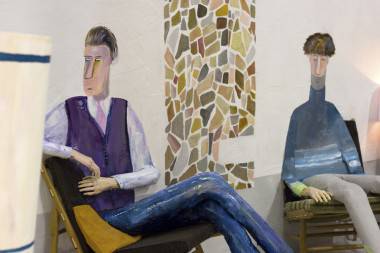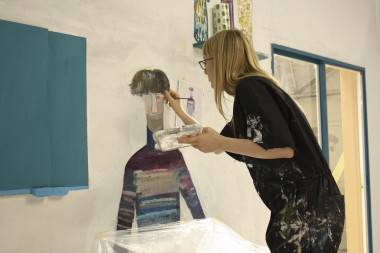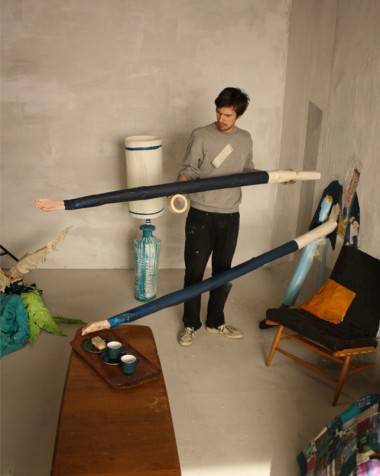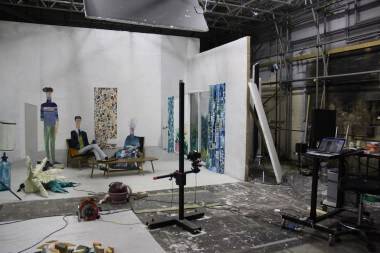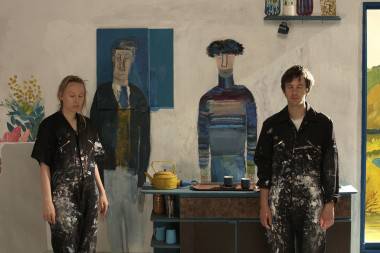Interview with BAFTA award winner Daisy Jacobs
A skilful marriage of both technique and storytelling, The Bigger Picture has found itself quickly becoming a firm favourite on the festival circuit, scooping awards around the world including a Cristal at Annecy. This success carried over to the award season, having recently won a BAFTA and received an Oscar nomination. Directed by Daisy Jacobs, the NFTS graduation film features brothers Nick and Richard and their differing approaches to their ill mother. Told through the eyes of the frustrated Nick, we are exposed to the full dynamic that these siblings share as their mother’s condition worsens. As Nick struggles to cope with his duty as carer, the “life sized film” method of animation displays his emotions as though they were another character in some wonderfully creative set pieces that were developed for the film.
We caught up with Daisy Jacobs to find out more about the film and what she and The Bigger Picture team have planned for the future.
The relationship between the two brothers really draws the audience into the film, how did you develop the characters in the writing?
I like characters that are complex and that have good and bad qualities. Richard’s good qualities would be that he is there with his mum, likes to chat and is jolly, whereas Nick isn’t that jolly, he is quite grumpy with it though he does do what is needed to be done when Richard isn’t there. So they are a mixture of good and bad, which is what I looked at when I wrote their characters.
Like a yin and yang approach?
Yes, but making sure they were not too far good or bad.
What drew you to the story?
I was interested in the family dynamics when someone is ill and the care that is needed. I think it is a difficult time for families and it is certainly one that we had to deal with in our own family, so I think there is something in my own experiences that I wanted to look at.
What do you think using animation brought to the story?
I think the key thing about animation and objects is that the room is almost another person, or an extension of a character; When Nick is feeling angry the room is responding in that way or what he is doing is exaggerated, so when he pours tea it can overflow or he can hoover up everyone in the room. We get a sense of how he is feeling through something surreal happening, which animation lends itself to.
The film showcases how life-size animated characters interact with the scenery and set. How did you develop this technique?
In my first year at the NFTS I did two tests – a life sized painting on its own where you couldn’t tell that the characters were large, so I did a second test where they started to interact with objects. Initially it was just paper and it was set in an office because paper is very light and from there we did tests with real arms coming out so they could reach further into the space. Then when we made the actual film it was even more complex – two characters acting, loads more arms to animate, motion control and plenty of things that I hadn’t been able to test, but we had a good idea of the core technique before we started.
So when you began with the grand scale were there any surprises that you were not expecting?
I think what really surprised me was that some aspects that I thought would take a long time – such as the hoover suck up – were really quick, whereas other sections such as the explosion took such a long time. I think the main surprise was not knowing how long things would take and being surprised by how long some things were. When we stopped using motion control everything became so quick because having the extra thing to think about made such a huge difference to the time.
I want to ask you a bit more about the technique with the forced perspective, how do you attach them to the wall?
With a staple gun!
Was it difficult keeping the arms up in the air? Didn’t you use any rigs?
No, sometimes we’d use bits of tape, but in our next film we will be looking into using rigs, although we seem to manage using the staple gun!
How much paint did you get through?
So much paint! We ordered four boxes and when they came through on the first day I thought they looked so tiny, so I had to use cheaper paint underneath and use the expensive paints sparingly on the top layer.
When you pitched the idea to the NFTS to make a large, room-sized set what was the reaction?
Well, I actually needed one of their main spaces for six months. It was a space that doesn’t belong to the animation department, it belongs to the cinematography department. At the NFTS you have green light meetings where you have to pitch you idea with storyboards, scripts, miniatures and everything else you’d need in the real world and really convince everyone that the project is worth doing. For me it was a very split decision, some people were really up for it and others couldn’t see the benefit of it being life-sized or didn’t quite understand what I was trying to do. That was a very challenging time for me, to be able to convince everyone, but once I did I received a lot of support from the school.
Was the film all filmed in camera?
Yes, it’s all in camera other than one link between the hospital tunnel to the hospital bed, but everything else was done in camera.
What can you tell us about your experience at the NFTS, is it a nurturing environment and do they develop you as a filmmaker?
I think what the NFTS is good for is learning how to work with others by the fact that they have different departments such as the cinematography department, the editing department, the writing department and so on, which means that you all work together on the final film which works really well, so you have a ready-made crew. The are also really heavy on story and storyboarding in the first year, which is really essential as a storyboard is the most important thing to use when you’re working with others; It’s the thing that everyone can understand and take away and add their own things to. I think that’s the most important thing for me.
A big thumbs-up, then.
Yes, it’s a very challenging environment. I’m not sure if ‘nurturing’ is the right word, I think they obviously try to bring out the best in you by making it a competitive environment that reflects the real world, so maybe tough love is better!
You turned towards Kickstarter to fund your next project. Can you tell us a little about the project?
I seem to have problems not being able to not work, so I have to move straight onto the next one. This next film is again to do with family and based on my own experiences. It’s to do with the idea of dispersal, people drifting apart and not staying connected to each other anymore. It’ll be the life-sized technique again and I’ve got lots of new ideas for it that we have been testing, so the Kickstarter is really essential. Even though I’ve raised a lot of money through awards which I’ll be adding to the budget, we still need the full amount from Kickstarter. It’s exciting and we will start animating in June.
The Bigger Picture is one of five films competing for the “Short Film Animated” award at this year’s Oscars. Vote for your favourite in our poll here. To learn more about the film visit thebiggerpicturefilm.com


